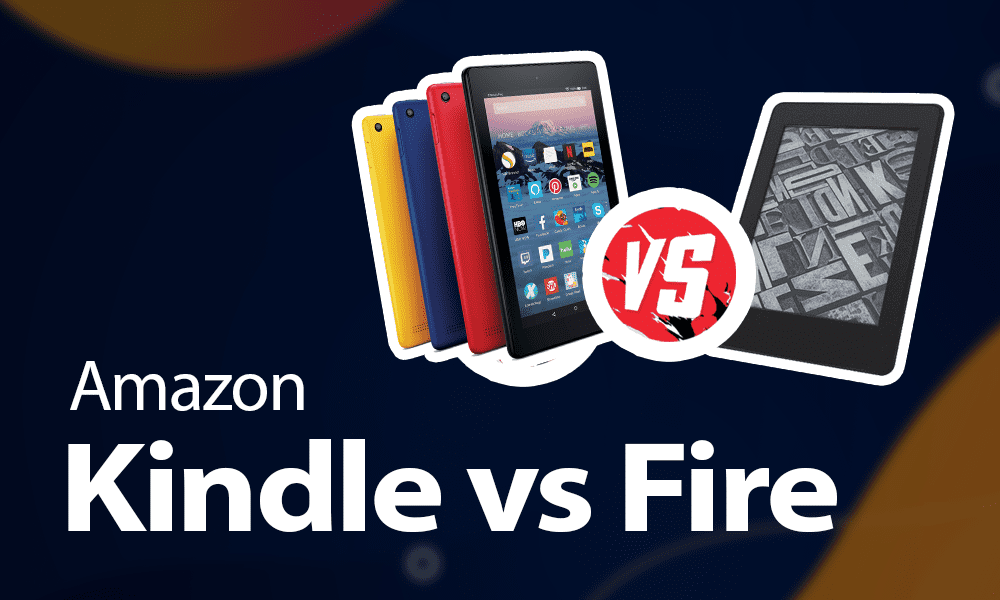Amazon Kindle vs Fire Tablet: Which Is Better in 2022
Amazon has two separate lines of products that could be considered tablets: Kindle e-readers and Amazon Fire tablets. But what’s the difference between them? Keep reading this Kindle vs Fire comparison to find out which device you should get.
The Amazon Kindle and the Fire tablet are two types of devices that have some overlap in their uses. This can make figuring out which one to get a confusing experience. In this Kindle vs Fire comparison, we break down all the differences to identify which one best suits your needs.
Key Takeaways:
- Kindle e-readers and Amazon Fire tablets are very different devices with different use cases.
- If you’re looking for a device for reading e-books, you’ll want to get one of the various Kindle models.
- On the other hand, if you’re in the market for a budget-friendly Android tablet that integrates seamlessly with Amazon’s services and marketplaces, then consider one of the Fire tablets.
Some of the confusion between the two probably stems from the fact that the Fire tablet used to be known as “Kindle Fire,” even though it has very little in common with the basic Kindle, Kindle Paperwhite or Kindle Paperwhite. Read on for a closer look at how these devices differ.
Sure, you can read e-books on almost any device. The Kindle app comes pre-installed, but you can also install other e-reader apps from the Amazon app store and load e-books onto your device manually.
Because both Kindles and Fire tablets integrate with Amazon’s core ecosystem, it’s in the company’s best interest to get its devices into as many hands as possible. Since the devices are designed to get the user to purchase books, movies, TV shows and magazines directly from Amazon, making a huge profit on the hardware isn’t that important.
No. The Kindle differs from a tablet in terms of both hardware and software. For one, it has a grayscale e-ink screen that’s more pleasant to read on. It also runs its own Kindle operating system, which is mostly limited to purchasing and reading e-books.
Amazon Kindle vs Fire Tablets Comparison
The Kindle e-reader is designed for reading e-books and not much more, whereas the Fire tablet has more in common with other budget-friendly Android tablets, like the Lenovo Smart Tab.
The Fire tablet is designed for watching videos, browsing the web and anything else you’d do on a regular tablet. Of course, you can still read books on it, but it’s not specifically designed for reading like the Kindle is.
1. Amazon Kindle vs Fire: Pricing
The various Kindle models and the Amazon Fire tablets are relatively budget-friendly devices.
Amazon Kindle Pricing
For the Kindle e-readers, there are four main models to consider, as well as two designed for kids. The price ranges from $89.99 for the basic Kindle with ads to $299.99 for the premium 32GB Kindle Oasis without ads.
| Device: | With ads | Without ads |
|---|---|---|
| Kindle | $89.99 | $109.99 |
| Kindle Paperwhite | $139.99 | $159.99 |
| Kindle Paperwhite Signature | N/A | $189.99 |
| Kindle Oasis 8GB | $249.99 | $269.99 |
| Kindle Oasis 32GB | $279.99 | $349.99 |
| Kindle Kids | N/A | $109.99 |
| Kindle Paperwhite Kids | N/A | $159.99 |
You can make any of the Kindle e-readers $20 cheaper by choosing an ad-supported version, which means you’ll see ads for Kindle Unlimited and recommended books on your lock and home screens. If you’re not sure which of these models is for you, make sure to check out our Kindle model comparison for all the details.
Amazon Fire Tablets Pricing
Similarly, there are five main models of the Amazon Fire tablet. These are the Fire 7, Fire HD 8, Fire HD 8 Plus, Fire HD 10 and the Fire HD 10 Plus. The first three models also have two versions each designed for children (Fire Kids and Fire Kids Pro), which makes for a total of 10 different versions of the tablet.
| Model: | 16GB | 32GB | 64GB |
|---|---|---|---|
| Fire 7 | $34.99 | $54.99 | N/A |
| Fire HD 8 | N/A | $44.99 | $64.99 |
| Fire HD 8 Plus | N/A | $64.99 | $84.99 |
| Fire HD 10 | N/A | $149.99 | $189.99 |
| Fire HD 10 Plus | N/A | $179.99 | $219.99 |
| Fire 7 Kids Pro | $49.99 | N/A | N/A |
| Fire HD 8 Kids Pro | N/A | $69.99 | N/A |
| Fire HD 10 Kids Pro | N/A | $139.99 | N/A |
| Fire 7 Kids | $49.99 | N/A | N/A |
| Fire HD 8 Kids | N/A | $69.99 | N/A |
| Fire HD 10 Kids | N/A | $139.99 | N/A |
The above prices are for the ad-supported versions — built-in ads on your lock screen — the versions without ads cost $15 more. Kids models are the exceptions; there are no ad-supported versions available. There are also several bundles, such as the bundle for the Fire HD 10 Plus, which includes a keyboard and a Microsoft 365 subscription.
2. Amazon Kindle vs Fire: Displays
The most obvious difference between a Kindle and an Amazon Fire tablet is the display. The various Fire tablets use an LCD display with a resolution ranging from 1024×600 on the cheapest model to 1920×1200 on the most expensive, whereas the Kindle e-readers use a completely different display technology.

This display technology is called the e-ink display and it’s what gives the Kindle e-readers the appearance of a physical book as opposed to a traditional screen. The matte finish eliminates glare and greatly reduces eye strain, so it’s perfect for reading a book for hours on end.
The trade-off is that the e-ink display isn’t able to produce anywhere near the picture quality of an LCD display, which is why it’s really only suited for reading.

Although you could use the Fire tablet to read books, the lack of e-ink display technology means that you’ll experience significantly more eye strain than with one of the Kindle devices.
3. Amazon Kindle vs Fire: Software
Another clear difference between Kindles and Amazon Fire tablets is the software. Fire tablets run on a version of Android developed by Amazon. Fire Tablets can’t access the Google Play Store, instead relying on the Amazon app store, where you’ll be able to find thousands of Android apps. That said, you can install the regular Android app store yourself by sideloading the Google Play Store APK.

The Fire tablet also comes with the Alexa app built in to every model, although the “show mode” feature is limited to the Fire HD 8, Fire HD 8 Plus and the Fire HD 10.

Kindles, on the other hand, run on proprietary Kindle firmware and there are no apps to speak of besides the ability to read Kindle books and listen to audiobooks from Audible.
This means that while the various Kindle devices are almost entirely focused on reading, the Amazon Fire tablet can be used to access tens of thousands of other apps that can stream video, make video calls and anything else you’d expect from a fully fledged Android tablet.
4. Amazon Kindle vs Fire: Hardware
There are other hardware differences between the two devices besides the huge difference in display technology. Since the Fire tablets are designed to do a lot more than the Kindle e-readers, they generally come with more storage, letting you choose between 16GB, 32GB and 64GB versions.
By contrast, most of the e-readers only come with 8GB of storage, except for the Paperwhite Signature Edition and the Oasis, which can go up to 32GB.

The difference in battery life is also huge. Where the Kindle e-readers are designed to last for weeks at a time, the Fire tablets sport a much more modest battery life of up to 7 or 12 hours depending on the model you choose. The Fire tablets also have built-in speakers, whereas the e-readers only support audio via Bluetooth.
Another obvious difference is that the Fire tablets have two cameras, whereas the Kindle e-readers have none. There’s also no microSD card slot on any of the e-readers.
There are also some differences in terms of charging, even among the tablets and the e-readers. The Amazon Fire 7 and all the e-readers — with the exception of the latest generation Paperwhite and Paperwhite Signature Edition — use micro USB ports for charging and connectivity.
Newer versions of the Fire tablet, such as the 8 or 10, as well as the new Paperwhite models all support USB-C cables and wireless charging.
Final Thoughts: Amazon Kindle vs Fire Tablets
That brings us to the end of our Amazon device comparison. To sum things up, if what you’re looking for is an affordable tablet or iPad alternative that you can use to watch videos, play games and stream movies, then one of Amazon’s Fire tablets is an excellent choice.
On the other hand, if all you need is a device to read books on, then the e-ink screens, reduced glare in direct sunlight and improved reading experience means that the regular Kindle is what you want (we have a Kindle user guide if you’re wondering “how does Kindle work?,” as well as a Kindle setup guide).
What did you think of our rundown of the various Amazon devices? Did it help you decide between an Amazon e-reader and an Amazon tablet? Are there any details about the Amazon ecosystem that you think we missed? Let us know in the comments below. Thank you for reading.

